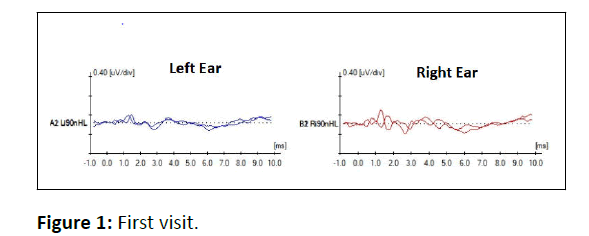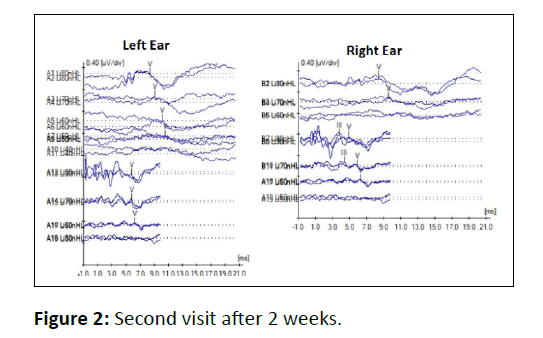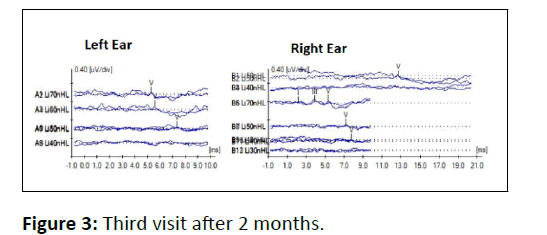Recovering Auditory Neuropathy Spectrum Disorder: A Pediatric Case Study from an Audio logical Perspective
Vishnu Mohan*
Department of ENT, Tutor in Speech Pathology and Audiology, JIPMER, Puducherry (U.T.), India.
- *Corresponding Author:
- Vishnu Mohan
Department of ENT,
Tutor in Speech Pathology and Audiology, JIPMER, Puducherry (U.T.),
India,
E-mail: mvrsl@uohyd.ernet.in
Received date: July 13, 2022, Manuscript No. IPMCRS-22-14182; Editor Assigned date: July 15, 2022, PreQC No. IPMCRS-22-14182 (PQ); Reviewed date: July 27, 2022, QC No. IPMCRS-22-14182; Revised date: August 08, 2022, Manuscript No. IPMCRS-22-14182 (R); Published date: August 15, 2022, DOI: 10.36648/2471-8041.8.8.238.
Citation: Mohan V(2022) Recovering Auditory Neuropathy Spectrum Disorder: A Pediatric Case Study from an Audio logical Perspective. Med Case Rep Vol.8 No.8: 238.
Abstract
Auditory neuropathy spectrum disorder (ANSD) is a peculiar hearing disorder among the retrocochlear hearing impairment category characterized by normal Otoacoustic Emissions (OAEs) with abnormal or absent Auditory Brainstem Responses (ABR). Literature evidences
Warrants the monitoring of hearing thresholds among high risk babies diagnosed with ANSD as there is a possibility of recovering the hearing loss in them. The present study demonstrates a 2 year 3 month old girl child who was diagnosed initially as ANSD, but later showed improvement in hearing to near normal level in 3 months. Close monitoring of all cases diagnosed with ANSD is recommended in view of the possible of transient nature of the disorder despite the presence or absence of OAEs.
Keywords
Reversible hearing loss; ABR; OAE; Cochlear microphonics; Auditory neuropathy
Background Information
ANSD (Auditory Neuropathy Spectrum Disorder) is a disorder related to the auditory system where cochlear and retrocochlear levels of lesion are observed with varying amount of pure tone thresholds and speech perception abilities. The common electrophysiological tests involved in the diagnosis of ANSD are Otoacoustic Emissions (OAEs) and Auditory Brainstem Responses (ABR) tests. These electrophysiological tests results have led to the understanding that ANSD may be caused by various lesions in the inner hair cells, the junction between the inner hair cells and the nerve, and the spiral ganglion or the auditory nerve while the activity of Outer Hair Cells (OHCs) is preserved, resulting in discrepancies between pure-tone and speech comprehension thresholds [1,2].
According to the pathophysiology involved, the condition is a peripheral neuropathy involving the auditory nerve demyelination and this in turn shows non synchronized auditory nerve stimulation depicted as abnormal ABR responses [3, 4].
In the case of infants, ABR waveforms show prognosis over time, so hearing status should be monitored through audio logical test battery regularly [1].
Application of objective tests in neonates has brought a spectacular change in the detection and management of hearing loss. The main attribution to the hearing loss detected in early infancy which recovers over time was to delay in maturation or myelination in the auditory pathways.
To distinguish between transient conditions of ANSD which might resolve over the early infancy period from those cases of long-term permanent ANSD is almost impossible currently, thus it warrants the necessity for continuous monitoring of auditory maturation till 2 years of age [5]. Patients with auditory dyssynchrony display normal to profound hearing loss in the behavioral hearing threshold and large variations in the speech perception. The prevalence of transient ANSD ranges from 24- 65% in their study subjects. In the present scenario it is an impossible matter to define the nature, severity and possibility of recovery of hearing infants who have clinically manifested the signs of ANSD.
Madden et al., have reported even late recovery from transient ANSD as late as up to 2 years. Also the abilities in speech perception also were found to improve over time despite normal ABR results observed from the beginning [6].
Causes for transient Auditory Neuropathy
From the previous studies there are multitudes of etiology in relation to ANSD. Some of them explain on the cause as neuromaturational delay hyperbilirubinemia anoxia hydrocephalus and somewhat debatably, metabolic toxic or inflammatory factors . In some cases hereditary factors may explain transient ANSD [5-8].
Familial isolated delay of auditory maturation as well as presentation as a part of established syndrome such as maple syrup urine disease has been reported. Transient ANSD coexisting alongside delayed visual maturation in the absence of any known risk indicators has been described [9].
Case Report
A 2 year 3 month girl child was brought to the department following referral from paediatrics department for hearing screening. The reported complaint was reduced spoken language output and not responding to soft and moderate level sounds. After the routine transient OAE evaluation, the result was absent OAE response binaurally. Hence the child was taken for detailed audiological evaluation. ABR testing revealed bilateral no peaks at 90 dBnHL with cochlear microphonics (Figure 1). The presence of cochlear microphonics was confirmed after clamping the inserts to rule out the possible influence of stimulus artefacts. Tympanogram results revealed bilateral “As” tympanogram with absent reflexes. Physical examination showed intact eardrums in both the ears. The Receptive and Expressive Emergent Language Scale (REELS) test showed a slight delay in the expressive language age by a few months. The parents were counselled and demonstrated to monitor the child with intense speech and language stimulation. Recommended to repeat ABR after 3 months as part of monitoring the hearing status.
After 2 weeks the child was brought with a suspicion of improved hearing by parent and ABR was repeated. Both click and 500 Hz tone burst ABR was done. Surprisingly there was V-th peak response observed till 60 dBnHL for click stimulus in both ears and 500 Hz tone burst ABR was present till 50 dBnHL in left ear and till 70 dBnHL in right ear (Figure 2). OAE could not be done as the child was not compliant. This time parents were explained on the improvement in hearing noticed on ABR testing and recommended to repeat the test after 3 months as a part of monitoring hearing status.
Again after 2 months, the ABR test was done and the results revealed the presence of V-th peak till 50 dBnHL in left ear and till 40 dBnHL in right ear (Figure 3). Tympanometry revealed bilateral “B” type tympanogram indicating an outer/ middle ear dysfunction. Therefore the child was recommended to consult ENT for physical examination of the ears.
The parents of the child were also counselled regarding the importance of frequent monitoring of hearing status of the child which needs to be established both objectively and subjectively and also the impact of hearing in the development of speech, language and communication abilities and its further influence in the literacy and academic achievements.
Discussion
The transient nature of ANSD is a confounding parameter that the management options face a halt such that once purchased, the management options might go useless after the recovery. Previous studies evidences have also shown that the hearing recovers after a period of transition. However, the difficult part is predicting the duration of this period of transition and, whether the recovery will be complete or partial. In view of the linguistic, social and cognitive development in a child, the need of early hearing loss detection and intervention is of great importance so that the decision regarding selection of a management device is non-debatable. The only matter to look into is an appropriate fitment of the management option and continuous close monitoring of the behavioral responses from the child till the recovery occurs [1,2,5,8,10,11].
It is not uncommon that children who are fitted with hearing aids or in the waitlist for cochlear implantation regain hearing abilities on follow-up after a few months [5, 6,10, 11,12].
In the present study, the birth history and post natal history evidences does not indicate any potential etiology for a transient difficulty in hearing abilities in our child patient. Also the complaint aroused even after 18 months where the anecdotal reports says the auditory brainstem maturation happens. So the potential genetic cause for the transiency in hearing disorder needs to be ruled out such as those in cases like otoferlin, pejvakin and similar genes associated with ANSD [13,14] .
The attribution to the reversibility in hearing in this case as well like in most sensorineural hearing loss can be credited to auditory maturation and neural plasticity [1,2,5,6,10,15, 16].
But in the previous studies the auditory maturation was credited in high risk babies and that was considered an absolute predictor which gives a hope of improvement in hearing. Also the possibility of a complete or partial recovery in ABR and hearing threshold in high risk babies who initially had cochlear responses detected through OAEs was not the scenario in the present study where OAEs were absent in the first visit. Again in the later visits OAEs were confounded by middle ear status.
The need for an amplification devices are sought especially when an objective and subjective response from the child indicates a hearing dysfunction. But cases like the present one pulls in the confusion and indicates that these children also need a less aggressive treatment protocol of “wait and watch” similar to the one applicable to high risk babies. So repeated testing is warranted before the selection of management options, either hearing aids or cochlear implants. This in turn helps avoid anxiety in parents, unwanted costs in procuring devices, unfavourable labeling and discomfort for the patients.
Acknowledgements
The author would like to thank the parents of the infant for their co-operation.
References
- Eom JH, Min HJ, Lee SH, Lee HK. (2013) A case of auditory neuropathy with recovery of normal hearing. Korean J Audiol 17: 138-141.
[Crossref], [Google Scholar], [Indexed]
- De Siati RD, Rosenzweig F, Gersdorff G, Gregoire A, Rombaux P, et al. (2020) Auditory Neuropathy Spectrum Disorders: From Diagnosis to Treatment: Literature Review and Case Reports. J Clin Med 9:1074.
[Crossref], [Google Scholar], [Indexed]
- Starr A, Picton TW, Sininger Y, Hood LJ, Berlin CI.(1996) Auditory neuropathy. Brain 119 : 741-753.
[Crossref], [Google Scholar], [Indexed]
- Jeong SW, Kim LS, Lee YM, Ahn SY, Park JS. (2007) Clinical Characteristics of Pediatric Auditory Neuropathy. Korean J Otorhinolaryngol-Head Neck Surg 50: 759-65.
[Crossref], [Google Scholar]
- Psarommatis I, Riga M, Douros K, Koltsidopoulos P, Douniadakis D, et al. (2006) Transient infantile auditory neuropathy and its clinical implications. Int J Pediatr Otorhinolaryngol 70: 1629-1637.
[Crossref], [Google Scholar], [Indexed]
- Madden C, Rutter M, Hilbert L, Greinwald JH Jr, Choo DI. (2002) Clinical and audiolo gical features in auditory neuropathy. Arch Otolaryngol Head Neck Surg 128:1026-1030.
[Crossref], [Google Scholar], [Indexed]
- Attias J, Raveh E. (2007) Transient deafness in young candidates for cochlear implants. Audiol Neurootol 12: 325-333.
[Crossref], [Google Scholar], [Indexed]
- Attias J, Sohmer H, Gold S, Haran I, Shahar A. (1990) Noise and hypoxia induced temporary threshold shifts in rats studied by ABR. Hear Res 45: 247-252.
[Crossref], [Google Scholar], [Indexed]
- Spankovich C, Lustig LR. Spankovich C, Lustig LR. (2007) Restoration of brain stem auditory-evoked potential in maple syrup urine disease. Otol Neurotol 28: 566-569.
[Crossref], [Google Scholar], [Indexed]
- Coenraad S, Goedegebure A, Hoeve LJ. (2011) An initial overestimation of sensorineural hearing loss in NICU infants after failure on neonatal hearing screening. Int J Pediatr Otorhinolaryngol 75: 159-162.
[Crossref], [Google Scholar], [Indexed]
- Psarommatis I, Florou V, Fragkos M, Douniadakis E, Kontrogiannis A. (2011) Reversible auditory brainstem responses screening failures in high risk neonates. Eur Arch Otorhinolaryngol 268: 189-196.
[Crossref], [Google Scholar], [Indexed]
- Hof JR, Stokroos RJ, Wix E, Chenault M, Gelders E, et al. (2013) Auditory maturation in premature infants: a potential pitfall for early cochlear implantation. Laryngoscope 123: 2013-2018.
[Crossref], [Google Scholar], [Indexed]
- Moser T, Starr A. (2016) Auditory neuropathy--neural and synaptic mechanisms. Nat Rev Neurol 12: 135-149.
[Crossref], [Google Scholar], [Indexed]
- Santarelli R, Scimemi P, La Morgia C, Cama E, Del Castillo I, et al. (2021) Electrocochleography in Auditory Neuropathy Related to Mutations in the OTOF or OPA1 Gene. Audiol Res 11: 639-652.
[Crossref], [Google Scholar], [Indexed]
- Ganguly K, Poo MM.(2013) Activity-dependent neural plasticity from bench to bedside. Neuron 80: 729-741.
[Crossref], [Google Scholar], [Indexed]
- Sharma A, Cardon G. (2015) Cortical development and neuroplasticity in Auditory Neuropathy Spectrum Disorder. Hear Res 330: 221-232.
[Crossref], [Google Scholar], [Indexed]

Open Access Journals
- Aquaculture & Veterinary Science
- Chemistry & Chemical Sciences
- Clinical Sciences
- Engineering
- General Science
- Genetics & Molecular Biology
- Health Care & Nursing
- Immunology & Microbiology
- Materials Science
- Mathematics & Physics
- Medical Sciences
- Neurology & Psychiatry
- Oncology & Cancer Science
- Pharmaceutical Sciences



